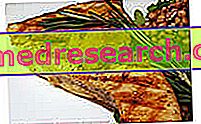Watch the video
X Watch the video on youtubeGenerality
Skin fungi are a group of microorganisms capable of causing various diseases affecting the epidermis and dermis, generally known as cutaneous mycoses (or dermatomycoses )

Skin fungi - Pityriasis Versicolor
Also called fungi, fungi are commonly found in skin flora and in the environment, but generally they are not a problem; in fact, they tend to "cohabit" with the human organism in the state of saprophytes, without harming you. All this thanks to several defensive factors that protect the human body from their excessive development.
In some favorable conditions, however, skin fungi can become invasive pathogens, behaving like opportunistic microorganisms . In practice, these mushrooms are able to "exploit" a state of immune weakness in the body to increase its colonies on the skin, to the point of causing a disease.
Not surprisingly, infections caused by skin fungi occur more frequently during the summer, when the heat and humidity typical of the summer season facilitate their growth and spread among individuals (considering the frequentation of crowded places, like swimming pools and beaches).
The symptoms associated with mycosis of the skin manifest themselves in the cutaneous sites and in the annexed structures (eg scalp, nails, genitals or skin surface) that they infect.
Epidemiology varies from one form of mycosis to another and is largely influenced by multiple environmental and subjective factors.
The diagnosis is based on the clinical appearance of the lesions, detected at the dermatological examination, and on the microscopic and cultural examination of the infected tissue.
The treatment depends on the site of infection, but generally involves the use of topical or oral antifungals, specifically directed to the skin fungus in question.
Features
- Mushrooms are saprophytic microorganisms (that is, they live in the environment feeding on substances derived from other organisms) or obligate parasites of plants or animals. Mycology experts are able to identify and classify mycetes based on their microscopic appearance and the method of reproduction, which can occur both sexually and asexually. The fungi that infect human skin are microscopic in size and may be single-celled ovoid (like yeasts) or multicellular and filamentous (like molds).
- Species that are pathogenic to humans can cause mycosis, intoxication or allergies . The diseases attributable to their presence can also be systemic, ie they can involve the internal organs of the human body (an example is aspergillosis, which affects the lungs), but the topical forms, that is localized on the skin, are far more frequent . Generally, skin mycoses are superficial and caused by dermatophytes or yeasts .
- The fungi are transmitted with great ease and can overcome the resistance of the barriers of the human body, settling in the skin. Almost all pathogenic species behave as opportunists, so they are able to take over in situations of immunosuppression (prolonged or frequent antibiotic therapies, use of cortisone drugs, chemotherapy, etc.). Furthermore, skin fungi proliferate in the presence of hot temperatures, high humidity, excess and stagnation of sweating, poor hygiene and variation in skin pH.
Main types
Mushrooms can be classified into three main groups:
- Dermatophytes : they are a particular type of pathogenic microorganisms that infect the superficial cutaneous layers (stratum corneum of the epidermis) and the keratinized appendages (hair, hair and nails), sites in which the presence of keratin (sulfur-rich protein) is abundant, they feed on.
The species Epidermophyton, Microsporum and Trichophyton belong to this category.
Dermatophytes are responsible for characteristic skin cockelaceous macules, with sharp edges and centrifugal evolution ( ringworm ). Some of these fungi can infect the trunk ( tinea corporis ), the feet ( tinea pedis or athlete's foot ), the nails ( tinea unguium ) and the inguinal folds ( tinea cruris ). These infections constitute about 40-50% of all superficial fungal infections and differ from candidiasis as they are rarely invasive.

Fungi of the Skin - Tinea Pedis (Athlete's Foot)
- Yeasts : unicellular and non-filamentous microorganisms that reproduce asexually in a very short time, localizing in hot-humid body areas (oral cavity, armpits, submammary folds, interdigital spaces, anogenital region, etc.).
Many yeasts are normally present on the skin and do not cause damage (they almost always coexist in the state of saprophytes).
The most important yeasts in dermatology are: Candida albicans, Malassezia furfur and Cryptococco neoformans .
Depending on the responsible mycotic agent and from the affected area of the body, the visible cutaneous manifestations may include edema, redness and pinkish-white desquamative patches; the itching is almost always present.
- Molds : they are multicellular and filamentous fungi that reproduce in a sexual way.
The most common pathogenic molds are: Alternaria, Aspergillus and Fusarium . These types of fungi are responsible above all for deep and systemic mycoses, while only in rare cases they cause skin and superficial infections.
Skin fungus infections
The cutaneous mycoses caused by the fungi of the skin comprise a group of rather heterogeneous infections, both for clinical aspects and for etiology.
In general, these diseases can be divided into two types:
- Superficial and cutaneous : limited to the superficial layer of the skin (epidermis), to the hair, to the nails and to the mucous membranes (oral cavity and genitals);
- Subcutaneous : extended to the dermis and to the connected structures.
Skin diseases due to fungi can affect everyone, regardless of gender and age. In most cases, people who develop cutaneous mycoses show a reduction in the immune response, for example due to an alteration of the local defenses (eg trauma with vascular compromise) or an immunosuppression (eg diabetes, AIDS, dysbiosis due to antibiotics etc.).
The transmission can take place from person to person, from animal (cat, dog, rabbit, mouse and cattle) per person and, rarely, from soil and objects contaminated to man.
The most common fungal skin infections are:
- Dermatophytosis: fungal infections involving the keratinized areas of the body (stratum corneum, hair or nails). The symptoms may be different, but in most cases they are skin lesions, which rarely lead to itching.
- Candidiasis: fungal infections that mainly affect the areas responsible for sweating, such as groin, armpits and interdigital areas. At the level of the mucous membranes, the oral cavity (eg, thrush), the genitals (eg vulvovaginitis due to Candida albicans ) and the esophagus (especially in immunocompromised subjects) can be infected.
- Pityriasis versicolor: cutaneous fungal infection in which the appearance of small irregular and flaky patches on the neck, trunk, abdomen, arms and face occurs.
Characteristic of the disease is the alteration of the skin pigmentation (dyschromia): the lesions are hypo- or hyper-pigmented and take on a color that varies from white to brown. The colonized skin areas, in fact, if exposed to the sun, hinder the passage of ultraviolet rays which, in normal conditions, stimulate the production of melanin.
Favoring factors
The mycotic manifestations are favored by the various factors that can compromise the local defenses and the ability of the immune system to react to infections.
These conditions include:
- Incorrect eating habits;
- Insufficient hygiene;
- Physical stress;
- Hot and excessive humidity;
- Situations of chronic skin maceration (excessive sweating, habit of wearing little breathable clothing);
- Prolonged antibiotic or cortisone based therapies;
- Immune defense compromised by particular pathologies (AIDS, tumors, diabetes etc.);
- Intake of immunosuppressive drugs.
Signs and symptoms
The symptomatology of fungal infections of the skin varies depending on the site (skin surface, hair, nails, etc.), while the virulence of the microorganism and the predisposition of the host determine its severity.
In general, skin fungi cause spots on the skin, white or reddish, asymptomatic or slightly itchy, with a flaky and slightly raised edge.
In some fungal infections, the lesions are whitish first, then they tend to become darker over time.
Most often, inflammation is poor or absent, but occasionally when inflammation is more severe it involves damage to the structures involved, which manifests itself as a sudden vesicular or blistering disease (usually at the level of the feet) or as a broad, soft lesion of the scalp that determines areas of alopecia (kerion).
Other symptoms associated with the presence of skin fungi include a burning sensation, blisters and sudden onset fissures (especially at the level of the feet), nail thickening and scalp flaking similar to dandruff.
Diagnosis
At the time of the dermatological examination, fungal infections of the skin have a rather typical clinical appearance, which allows diagnosis in a few minutes.
In cases where doubts remain, the dermatologist can take biological material (scales, hair, hair or nail fragments), by scarification or swabs, from the site of the mycosis, and then observe it under a microscope or subject it to a culture test .
For the differential diagnosis, the doctor may also use Wood 's lamp, which is able to detect a typical fluorescence (eg golden yellow of Malassezia, greenish for dermatophytes, etc.) and exclude these dermatosis infections not caused by fungi.
Once the type of skin fungus responsible for the clinical symptomatology has been identified (by culture test), the doctor can prescribe a specific therapy.
Treatment
Treatment is established based on the type of dermatomycosis and the responsible agent.
Generally speaking, local antifungals (topical sprays, creams, mousses, lotions, powders, enamels, detergents and shampoos) are available.
Oral antifungals are used mainly in resistant skin mycoses and in patients who are not cooperative or unable to adhere to prolonged topical regimens; drug doses and duration of treatment differ according to the site of infection.
To help relieve itching and pain, the doctor may indicate the use of topical corticosteroids (such as hydrocortisone) for the first few days. Rarely, for the treatment of severe inflammatory lesions, corticosteroid drugs are also used to be taken orally.
To learn more: Drugs for the treatment of Skin Mycoses »
Prevention
The main rules to prevent a possible fungal skin infection include:
- Use personal linen (towels, clothes, etc.) to avoid the risk of transmission of fungi from an infected individual.
- Always wear slippers in common showers, in swimming pools and in public services, as humidity promotes the growth of fungi.
- Do not use tight-fitting clothes made with artificial fibers, as they hinder the evaporation of sweat, change the pH of the skin and promote moisture stagnation.
- Choose the right detergents to maintain the defensive properties of the skin against fungi (eg eudermic cleansing bases instead of soap) and dry well after a shower.
- Do not abuse famaci : antibiotics and corticosteroids should be taken only with the advice of a doctor and for a limited time, as they can weaken the immune system and favor the attack of microorganisms, such as skin fungi.



